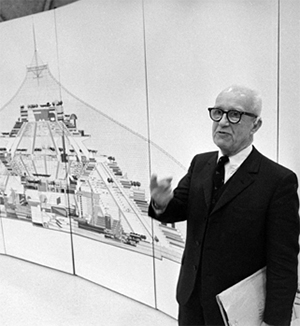

One of Fuller's main body of ideas has to do with the concept of synergetics, a major contribution to design science. Nature employs certain principles encompassing the physics, chemical/molecular makeup, and diverse biological and ecological systems we see around us in the world.
In his two volume work on the subject, he describes synergetics as:
"A system of mensuration employing 60-degree vectorial coordination comprehensive to both physics and chemistry, and to both arithmetic and geometry, in rational whole numbers... Synergetics explains much that has not been previously illuminated... Synergetics follows the cosmic logic of the structural mathematics strategies of nature, which employ the paired sets of the six angular degrees of freedom, frequencies, and vectorially economical actions and their multi-alternative, equi-economical action options... Synergetics discloses the excruciating awkwardness characterizing present-day mathematical treatment of the interrelationships of the independent scientific disciplines as originally occasioned by their mutual and separate lacks of awareness of the existence of a comprehensive, rational, coordinating system inherent in nature."
Fuller was clearly a generalist in this respect. He saw connections between vastly different subject areas, and sought to create an overarching set of design principles that encompassed these observations.
Fuller wanted to find a geometry within not just nature itself, but in human thought as well. However, it becomes evident immediately to the reader that Fuller himself was not the world's best writer. His role was as a thinker, and during lectures he often simply "thought out loud," choosing his words as carefully as possible to explain exactly, in literal scientifically-precise terms, what he meant to convey.
A practical example of applied synergetics in the field of architecture is Fuller's idea and deployment of 'tensegrity.' This is essentially utilizing the forces already present in geometrical shapes for maximum efficiency and resiliency. This general idea can apply to many other areas as well, such as the science of permaculture, or the energy management strategies that go into designing large systems and facilities. This is a major example of the "more with less" philosophy (which he refered to as 'ephemeralization') that was key to much of his thinking concerning long-term human sustainability.
One of his famous quotations was, "[The] Universe is nonsimultaneously apprehended."
As a nod perhaps to Alfred Korzybski and the study of general semantics, this statement alludes to the neurologically-relative conditions of human consciousness and the human nervous system that, like a goldfish swimming in water, we oftentimes fail to realize when we are certain about a particular belief system or a conditioned way of thinking.
As for ephemeralization, it can roughly be seen as another major important idea in the mind of Buckminster Fuller. As applied to our understanding of resource management and the carrying capacity of the earth to support human life, Fuller supplanted a comprehensive inventory and economic-statistical study, ultimately proving Thomas Malthus' contention that the human population was increasing more rapidly than life-supporting goods and services wrong. Fuller realized that accelerating human knowledge and hence technology was absent from such a composite picture of the world that led him to realize a set of circumstances were at work in which humanity has been constantly 'doing more with less' at a progressive rate. He speculated that humanity's ever-growing addition of new knowledge applied to the physical resources that go into life-supporting goods and services was on the verge of transforming the human condition in profound ways.
Hand-in-hand with this notion came the birth of the World Game, a simulation that examines the global situation of known factors concerning matter and energy resources. The process of modeling the complex factors of ecosystems, human populations, availability of targeted areas for high-energy concentration (e.g., the best areas for solar power harnessing, wave and tidal power, wind farming, etc.) may seem daunting, but the World Game has consistently provided thousands of students and researchers with insight and novel ideas, attitudes, and approaches towards tackling global problems and designing more efficient and economical ways to make the world a tangibly better place for more and more people.
These are only some of the major ideas that Fuller has shared with the planet. For more information about these topics, visit:
http://en.wikipedia.org/wiki/Synergetics_(Fuller)
http://en.wikipedia.org/wiki/Ephemeralization
http://en.wikipedia.org/wiki/World_Game